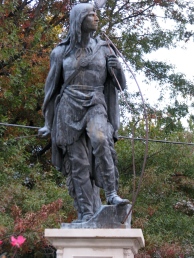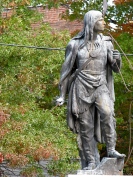A few days ago, Rob Gavel asked neighbors on the Historic Stockade Yahoo! Group mailing list if anyone had a “a full-body image of Lawrence” that could be used in a project for the Stockade Association. To my surprise, as I searched my online and computer photo collections, I did not have a simple full-body portrait of our beloved Lawrence the Indian, sans pedestal and Circle. The Stockade’s monument to Lawrence, or his traffic circle and “park”, appears in many of my photographs and webposts, but Lawrence is customarily just part of the tableau or background for one neighborhood event or another (e.g., the Valentine flamingo visit, our Christmas tree, Stockade-a-thon, or the Outdoor Art Show).
 Rob’s request made me realize that I need to take a closer look at Lawrence himself. Yesterday afternoon, I did just that, on a sunny, mid-October Saturday (and also on Friday, October 16). Below you will find a few portraits of Lawrence the Indian, an icon of our Stockade neighborhood, along with some facts about him and his statue. [As always, click on a photo for a larger version.]
Rob’s request made me realize that I need to take a closer look at Lawrence himself. Yesterday afternoon, I did just that, on a sunny, mid-October Saturday (and also on Friday, October 16). Below you will find a few portraits of Lawrence the Indian, an icon of our Stockade neighborhood, along with some facts about him and his statue. [As always, click on a photo for a larger version.]
- share this posting with the short URL: http://tinyurl.com/StockadeLawrence
– update (Feb. 2, 2010): the above pose is used for the new Stockade Gateway Banner, which was the project Rob Gavel had in mind when he sought Lawrence images –
– follow-up: I didn’t know when I was taking Lawrence’s banner photo that 2009 was apparently the only year that Lawrence’s feather’s were leaning toward his left. The consensus, formed at the time he was refurbished in 2012, is that his feathers should be standing upright.
“Lawrence” was among the Native Mohawks who encouraged the Dutch to resettle the village of Schenectady after a 1690 attack, in which French-Canadian and Indian marauders burned the stockaded village to the ground and massacred many of its inhabitants. (see the Stockade Association [new link] history page) The “I Spy” website of the Mohawk Valley Library System has this to say about the Stockade monument known as Lawrence the Indian:
At the junction of Front, Green and North Ferry Streets, is the Indian monument which marks the northeastern extremity and blockhouse of Queen’s Fort that was built by 1705, after the massacre. The statue was placed at that site in 1887 and became known as “Lawrence the Indian.” Lawrence was named after the Christian Mohawk who was a great friend to the early settlers and the most persistent of the trackers of the retreating French and Indians after the 1690 raid.
. . .
 As discussed in February 2008 at my f/k/a weblog, our statue of Lawrence the Indian “was originally a carving done by wood carver Samuel Anderson Robb about 1860 for William Demuth, who was the leading cigar store Indian peddler. Demuth published a catalog of his wares and in 1872 Lawrence is listed as ‘No. 53 Indian Chief.’ In 1873, the J.L.Mott Iron Works purchased the design and listed him for $500 in their catalog of statuary. The Schenectady statue was purchased in 1887.” [See “Fargo, North Dakota: The Indian Statue,” put together by the Institute for Regional Studies at North Dakota State University.]
As discussed in February 2008 at my f/k/a weblog, our statue of Lawrence the Indian “was originally a carving done by wood carver Samuel Anderson Robb about 1860 for William Demuth, who was the leading cigar store Indian peddler. Demuth published a catalog of his wares and in 1872 Lawrence is listed as ‘No. 53 Indian Chief.’ In 1873, the J.L.Mott Iron Works purchased the design and listed him for $500 in their catalog of statuary. The Schenectady statue was purchased in 1887.” [See “Fargo, North Dakota: The Indian Statue,” put together by the Institute for Regional Studies at North Dakota State University.]
Size. When asked how tall the Lawrence statue and base were, Stockade neighbor Rob Petito consulted the Smithsonian’s 1993 Inventory of American Sculpture, which states that [including his three small feathers] the statue of Lawrence is approx. 6’-3”, the upper base approx. 2’-7-1/2”, and the lower base approx. 4’-2”. That makes the total height approximately 13’-0” tall. Without counting the feathers, Lawrence himself is about 5′ 7″.
 In addition to our Lawrence the Indian, the J.L. Mott Iron Works model “#53 Indian Chief” statuary has had quite a few identities; the names and legends include:
In addition to our Lawrence the Indian, the J.L. Mott Iron Works model “#53 Indian Chief” statuary has had quite a few identities; the names and legends include:
- Chief Hopocan in New Portage Park, at the intersection of Norton Avenue and Wooster Road, in Barberton, Ohio.
- Tecumseh at the J. Fitzhugh Thornton Memorial, Thornton Triangle park in Cincinnati, Ohio
- Hiawatha at the Forest Glen Annex to Walter Reed Army Medical Center, Dewitt Circle & Linden Lane, in the Washington DC suburb of Silver Spring, Maryland [not Bethesda, MD, as stated in the Queen City Survey weblog, where you can find a discussion and a photo of Hiawatha]. Two photos of our Lawrence are standing in for his clone Hiawatha at Marv Solberg’s informative and comprehensive dcMemorials.com website.
- the Kisco Indian, at the Gorham Fountain, Mt. Kisco, New York, in Westchester County. According to a webpage from the Smithsonian Art Museum inventory catalog, “the sculpture “was first exhibited at the Centennial International Exhibition in Philadelphia in 1876. . . .The work was featured in Ripley’s Believe or Not in 1968.” Originally part of a water fountain and watering trough for horses, it was also meant to be “as symbol of the Prohibition Party.”
- a Cherokee named Sequoia, in Calhoun, Georgia
- an Indian unidentified by name or tribe in Fargo, North Dakota.
- “Wausaneta Indian”, Kiwanis Park, Leroy, Illinois. According to local archivist/librarian Bill Kemp:
“Although few know it today, this statue embodies LeRoy’s longtime ties to spiritualism, the belief that the dead have the means and inclination to communicate with the living.
“The idea for such a statue came from local resident and ardent spiritualist Simeon H. West, and he foot the bill to purchase, ship and install the pre-cast metal Native American and its elaborate pedestal. West claimed that on more than one occasion he communed with a deceased Kickapoo named Wausaneta, and he erected this statue as a tribute to the chief and his people.”
.
.
. . .. . . . . . . . . . . . . . . . . . . . . . . 
follow-up (Sept. 10, 2013): Indio Piel Roja, Plaza de Armas, Cusco. Peru. Thanks to a webpage authored by Vicente Goyzueta, I learned today that a Lawrence Clone that is no longer in existence once stood in the grand Plaza de Armas del Cusco, in Peru. Goyzueta, currently a resident of Tarrytown, NY, is a native of Cusco, and explains that “Qosqo [now known as Cusco] is actually the oldest living city in the American Continent, with a continuous settlement of more than 3,000 years. “
The webposting and photo-spread focuses on the striking similarity — “mismo” — between the Cusco Indian and Chief Kisko in Mount Kisko, NY. It also presents pictures of other versions of Indian Chief No. 53, including Lawrence. Goyzueta wrote me in an email today that:
“When I was a little kid I was impressed by the Indian statue in the Main Square of Cusco, later I learned that it was pulled down by a drunken journalist who did not like it. Once in NY, my sister told me about the story of Chief Kisko but I did not believe that it was an Inca placed there by mistake.”
The picture above was taken in 1945 by Frank Scherschel for Life Magazine. Clearly, Cusco’s Indio Piel Roja [“Red Skin Indian”] had a fancier pedestal situated in a grander plaza than our Lawrence. I don’t know anything more at this time about the history of the Cusco Indian or its symbolism or purpose.
The other versions of Mott’s “#53 Indian Chief” may look like our Lawrence, but none of them is nestled among the sights and people at the heart of the Schenectady Stockade.
follow-up (May 3, 2012): See our posting “Lawrence goes walkabout” (May 2, 2012), which describes — with many photos – Lawrence’s brief removal, after 125 years, so that he and his pedestal can be restored.








I always feel just a little safer in the Stockade knowing that Lawrence #53 is watching over us all.
By: Beverly on October 11, 2009
at 3:20 pm
Yep, and I’m glad ours isn’t called Hiawatha.
By: David Giacalone on October 11, 2009
at 7:14 pm
David,
Great Photos, thanks for posting all the time.
Steve
By: Steve on October 11, 2009
at 6:51 pm
Many thanks, Steve. It’s good to know you stop by occasionally.
By: David Giacalone on October 11, 2009
at 7:11 pm
It’s beautiful to read these things and articles. This was part of my dad’s ancestors Robert Lawrence. When I was a kid dad would talk about these things and also my grandfather Ambrose Lawrence. I would love to find more history about these things. Since dad passed I have been looking into these things to realize that my ancestors played a beautiful role.
By: Robert Lawrence jr. on October 14, 2023
at 2:51 pm
Hello, Robert,
Thanks for stopping by and leaving an interesting comment. It is suprising that 14 years after writing a post, it can still touch a reader interested reader. In addition to the Stockade Historty page [http://historicstockade.org./stockade-history/] of the Stockade Association, I suggest that you contact the Librarian at the Schenectady County Historical Society for more information about Lawrence and the Stockade. Best wishes.
By: David Giacalone on October 16, 2023
at 3:19 pm